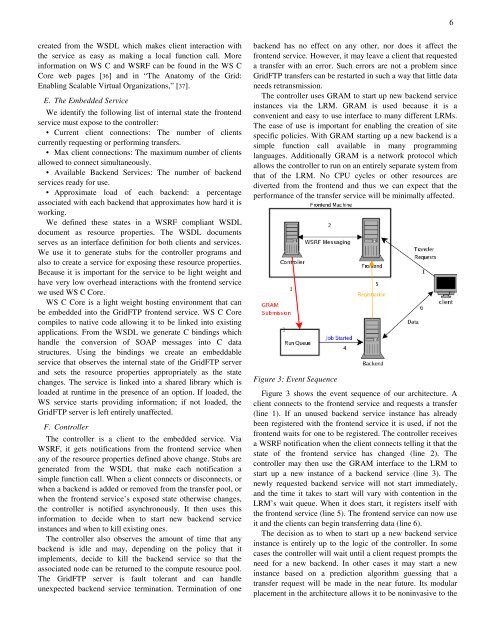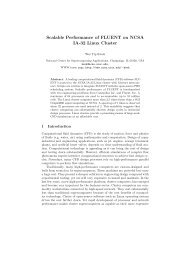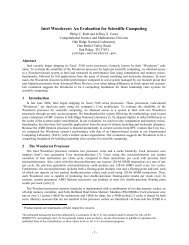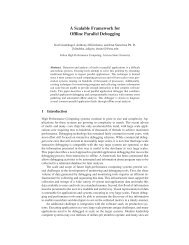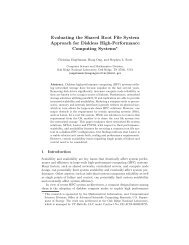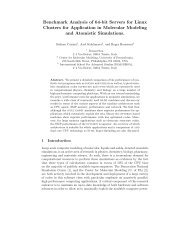6created from the WSDL which makes client interaction withthe service as easy as making a local function call. Morein<strong>for</strong>mation on WS C and WSRF can be found in the WS CCore web pages [36] and in “The <strong>An</strong>atomy <strong>of</strong> the Grid:Enabling Scalable Virtual Organizations,” [37].E. The Embedded ServiceWe identify the following list <strong>of</strong> internal state the frontendservice must expose to the controller:• Current client connections: The number <strong>of</strong> clientscurrently requesting or per<strong>for</strong>ming transfers.• Max client connections: The maximum number <strong>of</strong> clientsallowed to connect simultaneously.• Available Backend Services: The number <strong>of</strong> backendservices ready <strong>for</strong> use.• Approximate load <strong>of</strong> each backend: a percentageassociated with each backend that approximates how hard it isworking.We defined these states in a WSRF compliant WSDLdocument as resource properties. The WSDL documentsserves as an interface definition <strong>for</strong> both clients and services.We use it to generate stubs <strong>for</strong> the controller programs andalso to create a service <strong>for</strong> exposing these resource properties.Because it is important <strong>for</strong> the service to be light weight andhave very low overhead interactions with the frontend servicewe used WS C Core.WS C Core is a light weight hosting environment that canbe embedded into the GridFTP frontend service. WS C Corecompiles to native code allowing it to be linked into existingapplications. From the WSDL we generate C bindings whichhandle the conversion <strong>of</strong> SOAP messages into C datastructures. Using the bindings we create an embeddableservice that observes the internal state <strong>of</strong> the GridFTP serverand sets the resource properties appropriately as the statechanges. The service is linked into a shared library which isloaded at runtime in the presence <strong>of</strong> an option. If loaded, theWS service starts providing in<strong>for</strong>mation; if not loaded, theGridFTP server is left entirely unaffected.F. ControllerThe controller is a client to the embedded service. ViaWSRF, it gets notifications from the frontend service whenany <strong>of</strong> the resource properties defined above change. Stubs aregenerated from the WSDL that make each notification asimple function call. When a client connects or disconnects, orwhen a backend is added or removed from the transfer pool, orwhen the frontend service’s exposed state otherwise changes,the controller is notified asynchronously. It then uses thisin<strong>for</strong>mation to decide when to start new backend serviceinstances and when to kill existing ones.The controller also observes the amount <strong>of</strong> time that anybackend is idle and may, depending on the policy that itimplements, decide to kill the backend service so that theassociated node can be returned to the compute resource pool.The GridFTP server is fault tolerant and can handleunexpected backend service termination. Termination <strong>of</strong> onebackend has no effect on any other, nor does it affect thefrontend service. However, it may leave a client that requesteda transfer with an error. Such errors are not a problem sinceGridFTP transfers can be restarted in such a way that little dataneeds retransmission.The controller uses GRAM to start up new backend serviceinstances via the LRM. GRAM is used because it is aconvenient and easy to use interface to many different LRMs.The ease <strong>of</strong> use is important <strong>for</strong> enabling the creation <strong>of</strong> sitespecific policies. With GRAM starting up a new backend is asimple function call available in many programminglanguages. Additionally GRAM is a network protocol whichallows the controller to run on an entirely separate system fromthat <strong>of</strong> the LRM. No CPU cycles or other resources arediverted from the frontend and thus we can expect that theper<strong>for</strong>mance <strong>of</strong> the transfer service will be minimally affected.Figure 3: Event SequenceFigure 3 shows the event sequence <strong>of</strong> our architecture. Aclient connects to the frontend service and requests a transfer(line 1). If an unused backend service instance has alreadybeen registered with the frontend service it is used, if not thefrontend waits <strong>for</strong> one to be registered. The controller receivesa WSRF notification when the client connects telling it that thestate <strong>of</strong> the frontend service has changed (line 2). Thecontroller may then use the GRAM interface to the LRM tostart up a new instance <strong>of</strong> a backend service (line 3). Thenewly requested backend service will not start immediately,and the time it takes to start will vary with contention in theLRM’s wait queue. When it does start, it registers itself withthe frontend service (line 5). The frontend service can now useit and the clients can begin transferring data (line 6).The decision as to when to start up a new backend serviceinstance is entirely up to the logic <strong>of</strong> the controller. In somecases the controller will wait until a client request prompts theneed <strong>for</strong> a new backend. In other cases it may start a newinstance based on a prediction algorithm guessing that atransfer request will be made in the near future. Its modularplacement in the architecture allows it to be noninvasive to the
7rest <strong>of</strong> the system. It simply observes the running state andinjects new resources when its policy allows.V. EXPERIMENTAL STUDIESTo establish a pro<strong>of</strong> <strong>of</strong> concept <strong>for</strong> this architecture wedeveloped a prototype system. We implemented allmodifications to the GridFTP server specified above. Wecreated controllers to implement some basic policies,described in detail below. All tests were run using theUniversity <strong>of</strong> Chicago TeraGrid system, in which each nodehas a 1.5GHz Dual Itanium processor, 4 GByte RAM andGbit/s Ethernet. We use globus-url-copy as the client to thetransfer service in all <strong>of</strong> our experiments.A. Simple LRMThe University <strong>of</strong> Chicago TeraGrid system operates a PBSLRM with which our prototype can interact. However, thecluster is generally well used and the wait times <strong>for</strong> nodes canbe high. As this wait time is entirely dependent on outsidevariables, we could not use it in controlled experiments. Toaddress this problem, we implemented our own simple LRM<strong>for</strong> the purposes <strong>of</strong> experimentation. We then simulated acompute cluster by leasing TeraGrid nodes from PBS andusing those nodes <strong>for</strong> our own purposes within our simulatedLRM.We acquire one node from PBS to be the service provider.On it we run the GridFTP frontend service, the controller, theGRAM service, and the simple LRM. <strong>An</strong> additional set <strong>of</strong>nodes is acquired and designated as the compute/transfernodes <strong>for</strong> our simple cluster. One interface to the queue is ascript to be passed to the command line <strong>of</strong> the job to remotelyrun. The node on which the user job will be executed is chosenvia round robin selection. The job is then remotely executedon that machine via ssh [38]. In order to simulate the nontrivialqueue traversal time that is typically encountered in queuingsystems, the script will sleep be<strong>for</strong>e remotely starting theuser’s job. The sleep time is set in a configuration file that canbe changed dynamically.In addition to providing direct access to our simple LRM bycalling the submission script, we also provide a GRAMinterface. The GRAM ManagedJobFactoryService is designedto be configured to interact with a variety <strong>of</strong> LRMs, includingLSF, PBS, and others. We extended it to run against oursimple LRM as well. This way all <strong>of</strong> the XML messagingoverhead to the simple queue is the same as it would be to anyother queue. The only difference is the remote execution viassh versus the proprietary mechanisms used by the specificLRM.B. PoliciesWe evaluate our prototype system using four differentpolicies, which we now describe. Many other policies can beimagined (and can be implemented in our architecture); wechoose these policies to provide insight into the efficiency andapplicability <strong>of</strong> the architecture.1) Zero IdleThe zero idle policy does not allow a backend node to beidle <strong>for</strong> any time. Thus, nodes can neither be pre-fetched norcached. Each time a client connects to the frontend service andrequests a transfer, a request <strong>for</strong> a new backend serviceinstance is submitted to the LRM. When the transfer completesthe backend service immediately ends and the node it wasrunning on is released to the LRM <strong>for</strong> use in scheduling otherjobs. When using this policy, the amount <strong>of</strong> time it takes tostart a transfer is entirely dependent upon the wait time <strong>of</strong> theLRM and amount <strong>of</strong> time it takes <strong>for</strong> the notification to reachthe controller.2) Infinite IdleThe infinite idle policy is the exact opposite <strong>of</strong> the zero idlepolicy in terms <strong>of</strong> how it handles idle backend services. A set<strong>of</strong> backend service instances are started in advance and addedto the transfer pool. They are allowed to be idle <strong>for</strong> the lifetime<strong>of</strong> the frontend service and there<strong>for</strong>e the nodes on which theyrun are never returned to the computational pool. With thispolicy there will be idle backend services ready to handle aclient request at all times, until the system reaches maximumcapacity.3) N-IdleThe N-Idle policy is a simple approach to prefetching andcaching backend transfer nodes. The policy attempts to have Nbackend services idle at all times. When the system starts up,N backend services are created. These backend services areidle until a transfer is requested. When the transfer is requestedone <strong>of</strong> the N backend services is immediately allocated toservice the transfer request. Since there are now N – 1 idlebackend services, the controller implementing this policyrequests the creation <strong>of</strong> a new backend service in an attempt tomaintain N. Since creation <strong>of</strong> a new backend service takestime, there will not always be N idle, however the sum <strong>of</strong> idleand requested backend services will always equal N.4) Time CacheThe Time Cache policy allows a backend service to continuerunning and servicing transfer requests <strong>for</strong> the entire wallclockduration. Unlike the Zero Idle policy which returns the node tothe LRM immediately upon completion <strong>of</strong> its first and onlytransfer request, the Time Cache policy will continue to wait<strong>for</strong> additional transfer requests until its lease from the LRMtimes out. The assumption is that the time and ef<strong>for</strong>t requiredto obtain a node from the LRM is greater than that <strong>of</strong> a singletransfer and thus it is worth caching <strong>for</strong> its wallclock time. Themaximum amount <strong>of</strong> idle time is never greater than thewallclock time.The first two policies represent two extremes. Infinite idlerepresents an optimal policy from the perspective <strong>of</strong>connection time. Backend services are always ready, and soour architecture adds no additional overhead. Infinite idle isequivalent to the GridFTP proxy server without ourmodifications, with backend services statically assigned to afrontend and always available to it. In contrast, zero idleprovides the worst case scenario <strong>for</strong> connection time. Since


